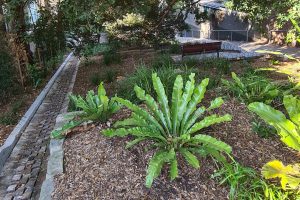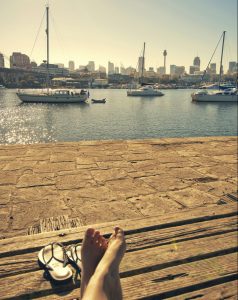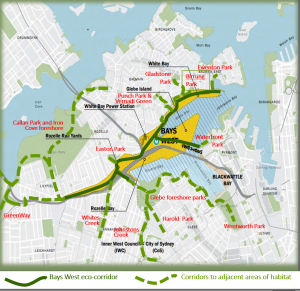By Andrew Wood, Convenor, from Bulletin 7/2021, September 2021

Introduction
The Subcommittee has 13 members and met on eight occasions during the year. At present, there are four landcare/bushcare volunteer groups in Glebe who are involved in the care and maintenance of our suburb’s parks: the Friends of Orphan School Creek Bushcare Group, the Friends of John St Reserve, Paddy Gray Reserve Landcare Group and the Glebe Palmerston and Surrounds Landcare Group. Many hours of volunteer work occurred as the Groups organised purchases of native flora, and planting and weeding working bees, as well as liaising with the City of Sydney Council about site work plans and upgrades.
We were delighted to receive generous donations from Norma Hawkins and Mary Holt during the year, which provided continuing financial support for the Subcommittee’s work.
Upgrades to parks
During the year, following extensive community consultation, the City undertook much-appreciated upgrades of Ernest Pedersen Reserve in Ferry Rd, and Palmerston Ave and Surrounds Park.
Craney Grants
Three Craney Small Grants totalling $4,550.00 were awarded to support biodiversity teaching and learning projects in our local preschools and schools (Native plant vertical garden – SDN Preschool Glebe; Connecting Country through classroom ecosystems – Explore and Develop, Preschool, Annandale; Glebe Public School environment project – Glebe Public School). On completing their project, each applicant will write a report which will be suitable for publication in the Society’s Bulletin and website.

Biodiversity lecture
The Society’s 6th Annual Biodiversity Lecture was given by John Turnbull, a Research Fellow from the School of Biological, Earth and Environmental Sciences at the University of NSW, on Tuesday 1 June 2021 at Benledi House, Glebe Library. His talk was entitled Biodiversity on our blue doorstep – fascinating creatures in Sydney Harbour and coastline and under COVID – safe rules was attended by 40 Society members and friends.
John is one of Australia’s leading experts in Sydney’s marine wildlife and conducts large surveys with the help of passionate local divers and citizen scientists. Sydney Harbour has over 600 endemic species of marine wildlife, and John pointed out that the number of fish species in our Harbour alone compares to the entire coastline of the UK. He explained that ocean currents, like the Eastern Australian Current (famously depicted in the movie Finding Nemo), make it difficult for marine wildlife to migrate away from the region, resulting in the local animals evolving in isolation. The wildlife in Sydney’s ocean is as unique as Australia’s wildlife on land.
Meeting with City regarding Bushcare Volunteer Guidelines
In November 2020, the Subcommittee met with Jenny Kent, the City’s Community Garden and Volunteer Coordinator, City Greening & Leisure and Aimee Freimanis, Ecohort Pty Ltd, the consultant developing the City’s Bushcare Volunteer Guidelines. The City needs to have a public-facing document to assist in recruiting and managing bushcare volunteers working in its parks and reserves. The aim is to produce a simple, instructive document that finds a balance between freedom and control, which will help both the City and volunteers, and become a model for new volunteers into the future. There was extensive discussion of the proposed contents of the guidelines especially concerning:
- insurance cover for the volunteers; other local governments provide full cover for volunteers from 18 to 90 years of age,
- the need for regular meetings between the City and the leaders of its voluntary bushcare groups,
- the need for site work plans for each of Glebe’s parks and reserves, including the maintenance of a database and map of works required at each site, and
- the provision (and onsite storage) of tools to be used by the bushcare volunteers.
In a recent email, Jenny Kent reported that ‘Unfortunately, there has been a significant delay with the development of the guidelines as Aimee had to withdraw from the project. I am getting back on to finalising a draft and will send it out for review when it’s available.’
City of Sydney’s crown lands plans of management
In December last year, the Subcommittee prepared the Society’s submission to the City, which addressed questions related to nine crown lands sites in Glebe. Also, members of the Subcommittee attended Zoom workshops and pop-up information sessions as part of the City’s community consultation process.
Important issues raised in the Society’s submission included:
- The remnants and reconstructed landscapes of rare green open space in Glebe provide opportunities for a renewed commitment to Indigenous sustainable management principles of ‘Caring for Country’. These management practices should support the health and well-being of the land (‘Country’). In recognising Aboriginal custodianship of these lands, local Aboriginal expertise should be sought where possible. The planting and maintenance of diverse native plant species to provide shade and habitat, a mix of native grasses, shrubs, small trees, ’native meadows’, dense small bird habitat and re-establishment of original vegetation should be encouraged to promote biodiversity, environmental awareness, and a sense of continuity with Sydney’s pre-1788 history.
- Since 1938 the central portion of Wentworth Park (the ‘sporting complex’) has been more or less the exclusive preserve of the greyhound racing industry, originally the National Coursing Association (NCA), and now the Greyhound Breeders Owners and Trainers Association (GBOTA). In 1985 the NCA built a massive grandstand, which now stands almost empty on racing nights, and which is effectively an office building in a public park. When the GBOTA licence expires in 2027, or before that, when greyhound racing ceases at Wentworth Park and the commercial leases in the grandstand come to an end, the whole of the park, including the sporting complex, should once again be accessible to everyone.
-

Morning Sunlight at Blackwattle Bay (image: Tina Reynolds)
Parks must be large enough to provide open spaces where people can be undisturbed and quietly enjoy passive activities such as sitting and reading a book. It will be necessary to actively manage the parks for their different uses so that peaceful, quiet zones are created in locations of natural ecosystems – all aimed at improving mental health and a connection with the local environment. Such sites should be free from lively activities and dogs. - Sporting activities should be confined to those open spaces where they currently take place. The one exception to this suggested limitation is that when the greyhounds depart from Wentworth Park, the greyhound track should become a public oval. Every open space should have clearly delineated, separate areas where dogs are not permitted as well as those where dogs should be leashed and where dogs should be permitted to run freely.
- ‘The Hill’ on the northern side of the Tramsheds shopping centre should be retained as a dedicated urban wildlife habitat refuge. Due to its contaminated land, ‘The Hill’ is currently fenced off from the surrounding area and cannot be used as a park open space. Its position, fencing and vegetation can provide an environment for abundant wildlife, including birds, lizards, bees and small mammals, to shelter and flourish. In the Society’s bird surveys, raptors, crested pigeons, brush turkeys and other birds have been identified on this site. Such a wild habitat refuge would be unique in the local government area and could also provide a safe site for the translocation of bird species, including the blue wren, which are no longer found in Glebe.
Federal inquiry into the problem of feral and domestic cats in Australia
The Subcommittee also prepared the Society’s submission to the Federal Government’s Standing Committee on the Environment and Energy inquiry into feral and domestic cats in Australia. Whilst it has been estimated that feral cats kill more than three billion animals per year, pet cat studies have shown that each roaming pet cat is responsible for killing 186 reptiles, birds and mammals per year. Thus, in urban settings such as Glebe, the problem of native wildlife destruction due to pet cats needs particular attention; per square kilometre per year, pet cats kill 30-50 times more animals than feral cats in the bush.
The Society has made the following recommendations to the inquiry:
- a national education campaign be launched to promote the protection of Australia’s unique native birds and animals and ‘To Make Every Cat an Indoor Cat’.
- Commonwealth funds be provided to all Local Councils to promote education campaigns specifically targeted to their local areas, ‘To Make Every Cat an Indoor Cat’, to encourage cat curfews and to enforce more responsible companion animal ownership.
- a National Competition be organised to encourage Australian artists and schoolchildren to create artworks illustrating the impact cats have on our native wildlife, with a view to the development of a nationally consistent Logo to ‘Make Every Cat an Indoor Cat’.
Annual Spring Bird Survey
The Society’s 8th bird survey was held on Sunday 1 November 2020; 16 people signed on at 6.45 am in Paddy Gray Reserve in Hereford St and were allocated to 10 survey sites across Glebe and Forest Lodge, including streets, parks and along waterways – participants spent 20 to 45 minutes surveying the birdlife at each site.
The survey results in 2020 were consistent with the 2019 survey regarding the number of species (26) and total individual birds (623). The two most common birds again were the native Noisy Miner and the Rainbow Lorikeet. Other native species becoming more common are the Australian Magpie and Australasian Figbird with Grey Butcherbird and Laughing Kookaburra also in the mix. Unfortunately, feral species such as Pigeons, Spotted Doves and Common Mynas are increasing in number. Species that we missed this year included cormorants, herons and other ducks. This could be attributed to the very high tide conditions and the ongoing disturbance in Johnstons Creek due to the creek naturalisation works.
However, there were more breeding records this year. This year, Tree Martins were observed using air vents in a building on the corner of Ross St and St Johns Rd, Forest Lodge. The Forest Lodge survey team were able to identify up to 10 birds flying in and out of the vents and reported chattering of baby birds as adults flew in and out. Although Tree Martins typically nest in natural tree hollows, they are also known to nest in artificial crevices, such as in buildings. The two Figbird nests were in Casuarina glauca in branches overhanging the pedestrian bridge and road into the Tramsheds precinct. One nest contained a sitting adult bird and in the other a juvenile bird, not yet fledged. Figbirds are likely to breed successfully in Glebe and Forest Lodge with street and park plantings of fleshy fruited trees such as Figs and especially the now widely street-planted Tuckeroo (Cupaniopsis anarcardiodes) as well as the continued presence of weedy species such as the Privet and Celtis.
While there were no surprises in this year’s survey, it was good to see one small species – a Willie Wagtail in the vicinity of Federal Park calling loudly, suggesting there might have been a mate somewhere nearby.

Proposals for wildlife corridors in the Bays West Place Strategy
In May, the Subcommittee (together with President and Convenor of the Bays and Foreshores Subcommittee) met with Keith Stallard, a Balmain resident and Society member, to discuss his proposals to have wildlife corridors included in State Government’s Bays West Place Strategy. Keith demonstrated that an eco-corridor should be an important and essential part of the Strategy with links to similar corridors in Glebe and Annandale and Callan Park, and the Greenway. Keith’s objective is to get eco-corridors, as a non-negotiable objective of the Bays West Place Strategy as this document will set the parameters for development of the Bays West precinct over coming decades. The meeting supported Keith’s proposals.










There are no comments yet. Please leave yours.